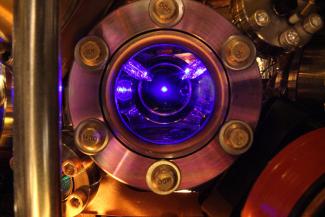JILA and NIST labs are well on the way to creating astonishingly accurate optical atomic clocks based on the neutral atoms strontium (Sr) and ytterbium (Yb). The new technologies are already capable of the most meticulous timekeeping in human history.
JILA Fellow Jun Ye’s group has developed an optical atomic clock that uses neutral Sr atoms held in an optical lattice (i.e., crystal of light) to generate the ticks of its clock. The Sr-lattice clock can precisely control the quantum states of more than 1000 atoms simultaneously. In 2012 (as recounted in The Most Stable Clock in the World), the group achieved record stability by operating the clock near the limit where quantum noise impacts clock performance. Now, a recent comprehensive evaluation showed that it is more accurate, reproducible, and stable than any other atomic clocks, including those based on single trapped ions. This achievement was reported online in Nature this week.
At NIST, Andrew Ludlow’s group at NIST uses Yb atoms to generate ticks for its super stable atomic clock, which shares many similarities with the JILA Sr-lattice clock, including stabilities basically at the same level. Ludlow, who trained at JILA under Fellow Jun Ye on earlier versions of the Sr-lattice clock, is now working on a comprehensive evaluation of the accuracy, reproducibility, and stability of the NIST Yb-lattice clock. The NIST Yb-lattice clock team also includes Chris Oates, who earned his Ph.D. under Fellow Jan Hall, and other JILA alumni.
The JILA Sr-lattice clock uses laser beams to trap the strontium atoms inside energy peaks and valleys created by light. The result is a clock that is 30 times more accurate and 300 times more stable than the cesium-based atomic clocks currently used as time standards in national laboratories around the world.
The most recent team responsible for developing JILA’s high performing atomic clock includes graduate students Ben Bloom, Travis Nicholson, Sara Campbell, Mike Bishof, and Sarah Bromley; former research associate Jason Williams; research associates Xibo Zhang and Wei Zhang; and Fellow Jun Ye. Many former graduate students and research associates have also contributed to the development of the Sr-lattice clock during the past decade.
The idea of using alkaline earth atoms, such as calcium and Sr, in atomic clocks originated in JILA and NIST in the 1980 and 1990s. In the early 2000s, researchers in Tokyo and JILA realized they could confine Sr atoms in optical lattices without affecting the clock ticks. The lattice largely protects the critical Sr clock transition from being perturbed by outside forces. This advance led to a goal of developing an ultrastable high-accuracy optical atomic clock that would not only work better than existing cesium-based time standards, but also outperform the promising single-ion optical atomic clocks invented in 2001 at NIST.
However, this dream did not come true for more than a decade. Inadequate laser stability prevented scientists from precisely measuring the pure signal produced by many Sr atoms. Now, research in the Ye group has yielded new laser technologies that have brought with them the ability to minimize quantum noise in the Sr-lattice clock.
Clear advantages of the Sr-lattice clock have already emerged. It contains thousands of atoms (as does the Yb clock). The intrinsic quantum fluctuations of these atoms average out during a single measurement of clock ticks; in contrast, ion clocks have only a single ion that flips back and forth between quantum states. It takes a longer time to average down the quantum fluctuations to achieve the same accuracy and reproducibility as the Sr-lattice clock.
The next step in refining the Sr-lattice clock is a study of the internal structure of the Sr atoms, which will allow theorists to more precisely predict clock perturbations due to the blackbody radiation that surrounds all atoms. In the meantime, the Sr-lattice clock is currently the best in the world, according to the recently completed evaluation. In fact, it is so accurate that it is allowing the Ye group to explore the intricacies of the quantum world, which consists of many interacting particles! And if all this isn’t exciting enough, the Ye group expects their clock to get even more accurate and stable in the future. — Julie Phillips




